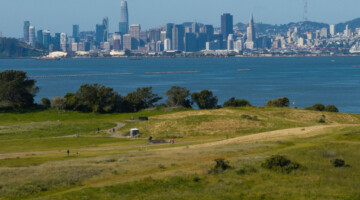We all hear how ‘cross is growing rapidly in North America. Kevin Richards takes a deeper look at this growth of the sport here in the states through this editorial.
Cyclocross Weaves a Web Across North America
By Kevin Richards
At its current growth rate, American cyclocross seems destined to soon be as ubiquitous as notebook computers and iPods. The irony is not lost on many American cyclocrossers, who note that after decades of top-down programs to develop internationally successful American cyclists in other disciplines, the fastest-growing cycling discipline of the 21st century has developed, in America at least, based on an ad-hoc network of regional series without the impetus of a strong central control, not unlike the growth of the internet. While International racing has always been the highest form of cycling, the traditional European concepts of what constitutes “National” and “International” becomes skewed in North America, where there are only two countries, both of which span the entire width of a rather large continent. The recently-announced North American Cyclocross Trophy, for example, starts with a pair of races less than 100 km from the Pacific Ocean and finishes with a pair of races within walking distance of the Atlantic Ocean, a span of four full time zones!
Yet, if the difference between “domestic racing” and “international racing” has different implications on opposite sides of the Atlantic, then the term “regional” can be completely misunderstood in the context of the American cyclocross scene. America is so vast that major cyclocross series such as the Zipp OVCX Tour, Cross Crusade and the Verge New England Championship Cyclo-Cross Series often encompass areas greater than many countries. The Zipp OVCX Tour’s geographic description of Ohio, Kentucky and Indiana is larger than all of Italy by more than 5,000 square miles (13,000 square km). And MAC’s 2008 schedule stretches from the Hamptons on the tip of Long Island, past the major cities of New York, Philadelphia and Baltimore all the way to the western suburbs of Washington DC. It’s a road trip that represents a distance only 50 miles (80 km) less than the total length of Belgium and The Netherlands combined[i].
However, the influence of these so-called “regional” series surpasses comparisons of their geographic size. Within the realm of international prestige, many of America’s biggest “regional” series compare favorably to entire countries on the 2008-2009 UCI cyclocross listings. Defending MAC champion Davide Frattini, for example, has more opportunities to score UCI points in the MAC series than in his native Italy; and World Women’s Champion Hanka Kupfernagel could score more UCI points in one weekend of MAC or Zipp OVCX racing than during the entire season in her native Germany. MAC’s schedule for 2008 offers more UCI points to competitors than all the UCI cyclocross races in England, Germany and Spain put together. If you were to split the U.S. into regions, MAC and Zipp OVCX would both still be ranked solidly in the top-ten of all nations in UCI points available for the 2008-2009 season. And, if you were to discount the points on offer for World Cups (which have thus far proven to be unavailable to U.S. promoters due to travel logistics and other reasons) then the MAC Series and the Zipp OVCX Tour would be the fourth and fifth ranked countries, respectively, in terms of available UCI points (behind only The Netherlands, Belgium and Switzerland).
Even America’s domestically-focused “regional” cyclocross series can have international implications. The BikeReg.com MABRAcross series, which has no UCI sanctioned races has drawn competitors from Italy and The Netherlands in recent years thanks in part to its proximity to Washington DC. On the opposite coast, the “Official Un-Official Single-Speed World Cyclocross Championship”, held last year in conjunction with the Cross Crusade Series, resulted in a stacked field of internationally ranked competitors, plenty of worldwide press coverage, and the most memorable podium photos of the year.
In contrast to the traditional nationalist model, the U.S.A. (and, to a lesser extent, Canada), has adapted to North America’s unique geographical challenges by developing a network of regional cyclocross series, each with a different personality representing the wide variety of regional cultures in this expansive continent. The regional networks are further augmented by continental series that often comprise races that are also part of their regional series; the Whitmore’s Landscaping Super Cross Cup in the Hamptons resort area of New York, for example, is part of both the MAC and the NACT series; and the USGP of Louisville is also part of the Zipp OVCX Tour. It’s a model that has been successful in professional sports here for over 100 years. Major League Baseball, America’s oldest (and in some ways biggest) professional sport, is divided into two separate leagues, with each league further split into three separate regional divisions. Professional football, basketball and ice hockey are organized similarly, as are collegiate sports which long ago learned the financial effectiveness and marketing benefits of universities and colleges banding together into regionally based “conferences” (i.e. leagues) with natural rivalries and fewer travel expenses.
While the U.S. arrangement of having multiple regional cyclocross championship series has evolved accidentally, (some would say “organically”), it has also developed considerable parallels to the organization those college sports. An American phenomenon, sports are big business on American university campuses, where top coaches frequently are paid more than their university’s president. Division 1 college football teams routinely draw as many as 100,000 people per game, and cities bid for the rights to host regional rounds of the collegiate basketball playoffs much like cities bid to be host cities for Tour de France stages. Like collegiate athletic conferences, some cyclocross series may have loftier and more prestigious goals than others, but the fact that some are regional in scope in no way belittles them. As any American sports fan will tell you, winning a football championship in one of the more prestigious “regional” collegiate conference such as the Big 10, SEC or the PAC 10 is a very big deal indeed.
Interesting Comparisons:
Driving distance from MAC’s northernmost race (Whitmore’s Super Cross Cup in New York) to MAC’s southernmost race (Capital Cross Classic): 294 miles. Driving distance from British Prime Minister’s Residence at #10 Downing Street in London to the Eiffel Tower in Paris: 212 miles[ii].
Driving distance between two most separated Cyclocross World Cup locations for 2008/2009 (Tabor, Czech Republic and Igorre, Spain): 1,221 miles. Driving distance between most separated North American Cyclocross Trophy Locations (Lakewood, Washington and Gloucester, Massachusetts): 3,099 milesi.
Population of Belgium(Flanders and Wallonia): approx. 10.5 million[iii]. Population of Metro New York area (location of three MAC races): approx. 18.9 million[iv].
Geographic area of Europe: 3,837,000 Sq. Miles[v]. Geographic area of Continental United States, not including Alaska, Hawaii or territories (i.e. “the Lower 48 States”): 3,119,884 square miles[vi].
Geographic area of Monaco, member nation of the IOC (and where pro cyclists Michael Rasmussen, Leonardo Piepoli and Lorenzo Bernucci hold/held their license through the Monaco Cycling Federation): 0.76 Square Miles[vii]. Geographic area of Rhode Island, America’s smallest state, 1,545 Square Miles[viii]
[i] Google Maps[ii] Google Maps[iii] https://www.cia.gov/library/publications/the-world-factbook/print/be.html
[iv] http://en.wikipedia.org/wiki/United_States_metropolitan_area
[v] http://www.enchantedlearning.com/geography/continents/Land.shtml
[vi] http://factfinder.census.gov/servlet/DTTable?_bm=y&-context=dt&-ds_name=DEC_2000_SF1_U&-CONTEXT=dt&-mt_name=DEC_2000_SF1_U_P001&-tree_id=4001&-transpose=N&-redoLog=false&-all_geo_types=N&-geo_id=01000US&-geo_id=04000US02&-geo_id=04000US15&-search_results=04000US15&-_showChild=Y&-format=&-_lang=en&-show_geoid=Y
[vii] http://www.visitmonaco.com/index.cfm?fuseaction=Page.viewPage&pageId=3
[viii] http://www.enchantedlearning.com/usa/states/area.shtml


























